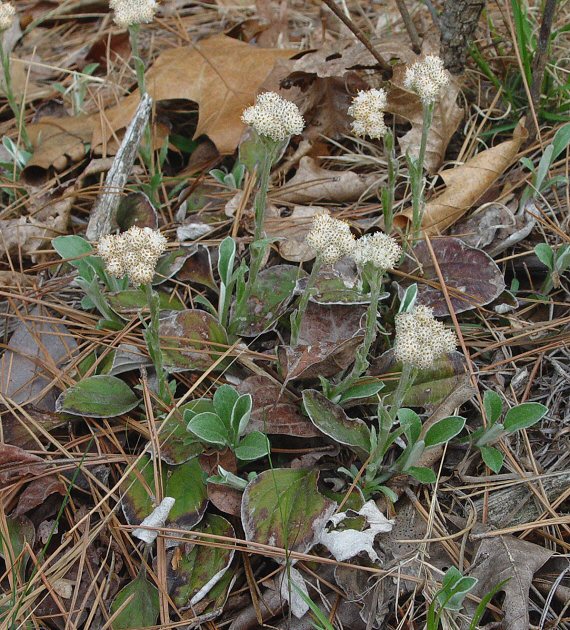Antennaria parlinii Fernald
Plainleaf Pussytoes

Native
CC = 5
CW = 5
MOC = 83
© DETenaglia
Antennaria parlinii FernaldPlainleaf Pussytoes | |
 |
Native CC = 5 CW = 5 MOC = 83 |
© DETenaglia |
|
Family - Asteraceae/Gnaphalieae Habit - Perennial, dioecious, colonial, fibrous-rooted forb, with densely woolly, leafy stolons. Stems - Flowering stems erect, 9-28 cm long, simple, densely woolly, sometimes becoming glabrous in patches with age.
Leaves - Basal leaves petiolate. Petioles to 3-4 cm long. Blades 2.5-9.5 cm long, 18-45 mm wide, entire, oblanceolate to more commonly broadly obovate or circular-obovate, rounded to broadly pointed at the tip, often with a minute, abrupt, sharp point, tapered at the base, the upper surface glabrous to densely woolly, the undersurface densely woolly, with 3 or 5 main veins. Stem leaves sessile, 0.5-4.5 cm long, linear to narrowly oblong-lanceolate, the lowermost often narrowly oblanceolate, entire, mostly sharply pointed at the tip, the upper leaves often with a short, hairlike extension of the midvein, truncate or somewhat rounded at the base, the blade tissue not extending along the stem below the attachment point, densely woolly on both surfaces or the upper surface sometimes only moderately hairy.
Inflorescence - Flower heads in compact terminal clusters. Heads - Heads discoid, with all staminate or pistillate florets. Receptacle flat or convex, naked. Involucre 7-13 mm long, densely woolly. Phyllaries to 5 mm long, 1.2 mm broad, green with scarious margins and long scarious apex, glabrous internally, in 1-2 series, imbricate. Staminate involucre slightly more broad and short than pistillate.
Florets - Corollas slender, those of the staminate florets shorter than those of the pistillate florets, tubular or those of the staminate florets narrowly trumpet-shaped, white or yellow, sometimes reddish or purplish-tinged, glabrous. Pistillate corollas 4.5 mm long, with an exserted, bifurcate style. Staminate corollas 2.5 mm long. Pappus of the pistillate florets of numerous slightly longer capillary bristles, that of the staminate florets of fewer slightly shorter bristles, the bristles all or mostly free and shed individually or in small groups, minutely toothed and sometimes slightly expanded and narrowly club-shaped at the tip. Ray florets absent.
Fruits - Achenes 1.0-1.5 mm long, narrowly elliptic-obovoid, the surface appearing pebbled or roughened with minute papillae, brown. Flowering - April - June. Habitat - Mesic to dry upland forests and prairies, savannas, ledges and tops of bluffs, glades, streambanks, pastures, roadsides, and open, disturbed areas. Origin - Native to the U.S. Lookalikes - A. neglecta. Other info. - This is a common little plant in Missouri, occurring throughout most of the state as well as most of the eastern U.S. It occurs most commonly in dry woodlands. In Missouri it is relatively easy to ID in the field, though farther west the genus becomes more difficult due to hybridization, polyploidy, and apomixis. Missouri's plants have been further subdivided into ssp. fallax and ssp. parlinii, with the distinction being based upon the nature of the basal leaf pubescence. A previously used species name, plantaginifolia, means "leaves of Plantain" and indeed the basal leaves do look like those of the genus Plantago. The other Missouri representative of the genus, A. neglecta, differs in having narrower leaves with only a single midvein. Photographs taken in the Piney Creek Wilderness, Barry County, MO., 4-5-04 (DETenaglia); also at Pickle Springs Natural Area, Ste. Genevieve County, MO, 4-26-2014, and Little Lost Creek Conservation Area, Warren County, MO, 4-14-2021 (SRTurner). |